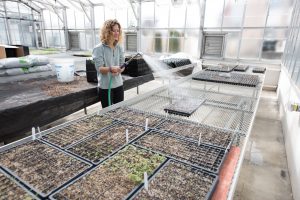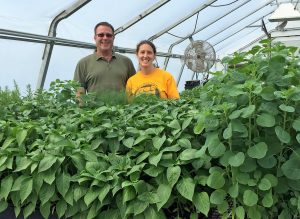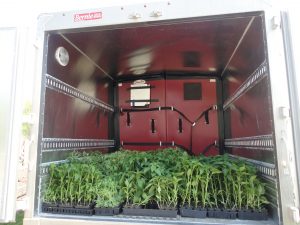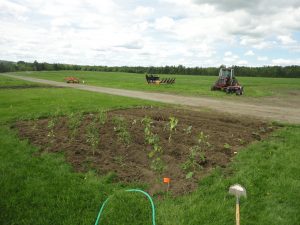It’s been an exciting couple of weeks for Huertas! Seeds and starts have been distributed and all the gardens have finally been planted. The whole endeavor began over five months ago, when field interns started visiting farms and interviewing Huertas participants in order to determine which seeds and starts each farm or family would be requesting this year. The totals from these interviews were put into a master spreadsheet, which at the end of the interview process was sent to the wonderful greenhouses that nurture starts for Huertas. This year there was an fantastic new collaboration on campus to help us grow many of the herbs and specialty starts. Mark Starrett, an Associate Professor and horticulture specialist in Plant and Soil Science, guided this collaboration. Chamomile, rue, epazote, papalo, chiltipin and guajillo peppers among many other starts were grown at the UVM greenhouse with the help of the UVM horticulture club, which covered the costs of pots, potting mix and space rental in the greenhouse. The starts were transplanted by various groups of volunteers, including the Green Mountain of Alpha Zeta (an agricultural/environmental honor society) and students from Rachel Montesano’s Spanish course, who also helped sow seeds. Once the starts were ready to be planted, they were handed off to Huertas, and our interns and volunteers sorted the starts into flats for each household (along with bags of their requested seeds) and distributed them to each of the 29 participating farms.
When I became involved with Huertas as an intern, I had absolutely zero gardening knowledge, so participating in this whole endeavor has been a huge learning experience for me. I was lucky enough to see or be involved in every step of the process: from collecting information during the interviews to distributing the seeds and starts, I saw firsthand how deeply this program relies on personal, human connections. Watching the field interns undertake these interviews in a language they’re not fluent in and watching the farm workers in turn help them along the way with what English they know was a really meaningful experience for me. Everyone brought what they could to the table and figured it out, together, from there. I also saw this kind of cooperation and understanding when I started going out to the farms on my own to help plant. I admitted right off the bat that I knew pretty much nothing, and instead of being disappointed the families and workers just laughed and taught me what they knew. They were more than willing to bridge the gap. Being involved with Huertas brings you into contact with these kinds of passionate, giving people, from the volunteers who transplant starts to people like Mark Starrett who supervise a large portion of all the starts we use for the year.
To everyone involved with Huertas: thank you for an amazing year thus far!
Nurturing starts in the UVM greenhouse (top), and fully grown starts ready to be planted (bottom)
Cultivar plantas en en vivero de UVM (arriba), y las plantas ya crecidas, listas para ser sembradas (abajo)
Transporting starts to St. Albans for sorting (top) and a newly planted garden (bottom)
Transportar las plantas a St. Albans para ordenar (arriba) y un jardín nuevamente sembrado (abajo)
*Our thanks to Jeff Clarke for the photos of UVM students working in the greenhouse. Nuestras gracias a Jeff Clarke por los fotos de los estudiantes de UVM trabajando en el vivero.
En español:
¡Han pasado unas semanas emocionantes para Huertas! Semillas y plantas han sido distribuidas y todas las huertas ya han sido sembradas. El esfuerzo entero empezó hace más de cinco meses, cuando unos estudiantes haciendo sus prácticas profesionales empezaron a visitar los ranchos y entrevistar a los trabajadores para determinar cuáles semillas y plantas cada hogar quería solicitar este año. Se metieron las cantidades totales de las entrevistas en una hoja de cálculo, la cual fue enviada a los viveros increíbles que cultivan las plantas de semillero para Huertas. Este año una colaboración nueva y fantástica en el campus de la Universidad nos ayudó a crecer muchas de las hierbas y plantas especiales. Mark Starrett, un profesor asociado y especialista de horticultura en el Departamento de las Ciencias de Plantas y Suelos, guió esta colaboración. Manzanilla, ruda, pápalo, chiltepín, y chile guajillo entre otras plantas fueron sembrados en el vivero de la Universidad de Vermont con la ayuda del club de horticultura de UVM, que cubrió el costo de las macetas, tierra para macetas, y el alquilar del espacio en el vivero. Varios grupos de voluntarios, incluyendo Green Mountain of Alpha Zeta (una sociedad de honor en agricultura y medio ambiente) y estudiantes de la clase de español de Rachel Montesano ayudaron a sembrar y trasplantar semillas. Cuando las plantas estaban listas para ser sembradas en el suelo, Mark las entregó a Huertas, y nuestros estudiantes haciendo sus prácticas profesionales y voluntarios organizaron las plantas en grupos para cada casa (con los paquetes de semillas que habían pedido) y las distribuyeron a cada uno de los 29 ranchos participantes.
Cuando me involucré con Huertas como una estudiantes haciendo mi práctica profesional no tenía ningún tipo de conocimiento sobre la jardinería, entonces participar con este esfuerzo ha sido una experiencia increíble de aprendizaje para mí. Tenía mucha suerte ver o estar involucrada en cada paso del proceso: desde juntar la información en las entrevistas hasta entregar las semillas y plantas, vi de primera mano que tan profundamente este programa depende de las conexiones personales y humanas. Observar las estudiantes hacer estas entrevistas en un idioma que no es su primer idioma y ver los trabajadores de campo también ayudarlas con el inglés que saben fue una experiencia muy profunda para mí. Todos aportaron lo que pudieron y resolvieron los desafíos juntos. También vi este tipo de cooperación y entendimiento cuando empecé a ir sola a los ranchos para ayudar a sembrar. Confesé de inmediato que no sabía nada sobre la jardinería, y, en vez de estar desilusionados, las familias y los trabajadores solamente se reían y me enseñaron lo que pudieron. Estaban más que dispuestos a acortar la distancia. Estar involucrada te pone en contacto con personas apasionadas y generosas, desde los voluntarios que trasplantaron las plantas hasta personas como Mark Starrett quienes supervisan una porción grande de las plantas que usamos para el año.
A todos que están involucrados con Huertas: ¡muchísimas gracias por un año increíble!



